Embark on a captivating journey into the realm of gas stoves, where innovation meets culinary convenience. Discover how these kitchen stalwarts have revolutionized cooking, becoming essential components of modern kitchens worldwide. From gourmet creations to daily meals, gas stoves play a pivotal role in shaping the way we approach cooking.

As technology progressed, gas stoves evolved from mere appliances to functional art pieces, blending seamlessly with contemporary kitchen aesthetics. Discover the narrative behind this culinary evolution that has forever transformed our cooking experiences.
Historical Overview
Early Innovations in Gas Stoves
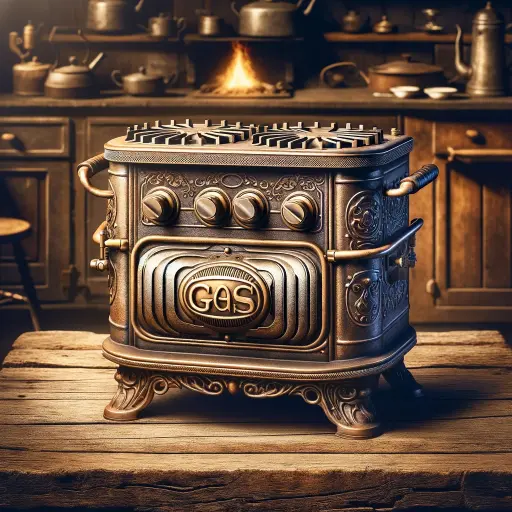
Take a step back in time to explore the ingenious minds that sparked the inception of gas stoves. Uncover the innovative concepts that led to the birth of the gas stove, bridging the gap between traditional open flames and modern culinary mastery. Delve into the stories of inventors who dared to reimagine the art of cooking.
Milestones in Gas Stove Development:
Embark on a captivating historical odyssey that chronicles the key moments in gas stove development. From humble beginnings to groundbreaking innovations, witness how engineering marvels, fuel advancements, and safety measures propelled gas stoves into the future. Each milestone tells a tale of ingenuity, turning everyday cooking into an experience of precision and delight.
Important Terminologies
Here are some important Gas stove terminologies:-
Stove Flames
Peer into the heart of gas stove functionality as we unravel the captivating science of flames. Discover the intricate dance of combustion that transforms fuel into heat, empowering your culinary endeavors. Gain a newfound appreciation for the delicate balance between fuel, air, and heat that results in delectable dishes.
Ignition Systems
Navigate the intricate world of stove ignition, where the magic of cooking begins. Journey through the evolution of ignition mechanisms, from traditional pilot lights to contemporary electric igniters.
Dive into the mechanics that bring your stove to life, igniting a symphony of flavors with each press of a button or turn of a knob.
How Stoves Work
Here is the complete process on how the stove works:-
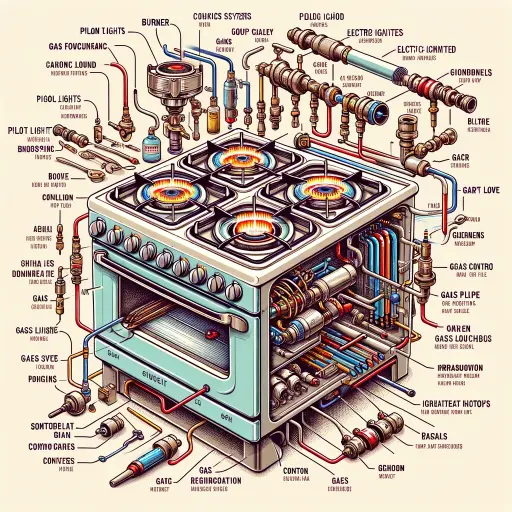
Igniting the Flame
Ignition to Heat Generation
Witness the mesmerizing transformation from a spark to a steady, vibrant flame as we unveil the ignition process of gas stoves. Experience the mechanics that initiate the culinary symphony, igniting your cooking adventure.
The Role of Gas Flow and Pressure Regulation in Stove Functionality
Delve into the core mechanics that govern your gas stove’s performance. Uncover how precise gas flow and pressure regulation lay the foundation for consistent heat delivery. With each adjustment, unleash a world of cooking possibilities that cater to your culinary desires.
Heat Distribution Mechanisms Explained: Ensuring Even Cooking

Explore the delicate dance between heat and cookware as we decipher the art of heat distribution. Navigate through the science that ensures each morsel receives uniform warmth, eliminating hotspots and guaranteeing culinary perfection.
With an understanding of these intricacies, you’ll wield mastery over your gas stove, turning ordinary ingredients into culinary marvels.
The Intricacies of Gas Stove Mechanics
Igniting the Flame
From Spark to Culinary Brilliance Embark on a visual journey as we break down the ignition process of gas stoves. Witness the initial spark, the dance of pilot lights, or the instantaneous glow of electric igniters.
Mastering Gas Flow and Pressure
The Key to Perfect Flames Delve into the science of gas flow and pressure regulation that underpins your stove’s performance. Adjust the knobs, and witness the responsive transition from simmer to sizzle, with precision at your fingertips.
Even Heat Distribution: Crafting Culinary Consistency

Uncover the science behind evenly distributed heat, ensuring your dishes are cooked to perfection. Bid adieu to unevenly cooked meals as you embrace the equilibrium that guarantees culinary delight.
Your gas stove is a symphony of precision, a marriage of science and culinary artistry. As you grasp the mechanics, you step into the realm of culinary virtuosity.
From Spark to Sizzle: How Gas Stoves Create Culinary Magic
Discover the enchanting process of igniting a gas stove. Whether it’s the classic flicker of a pilot light or the modern convenience of electric ignition, witness the birth of culinary potential with each gentle turn of the knob.
Perfecting Heat
Gas Flow and Pressure Mastery
Immerse yourself in the realm of gas flow and pressure, where minute adjustments yield remarkable culinary results.
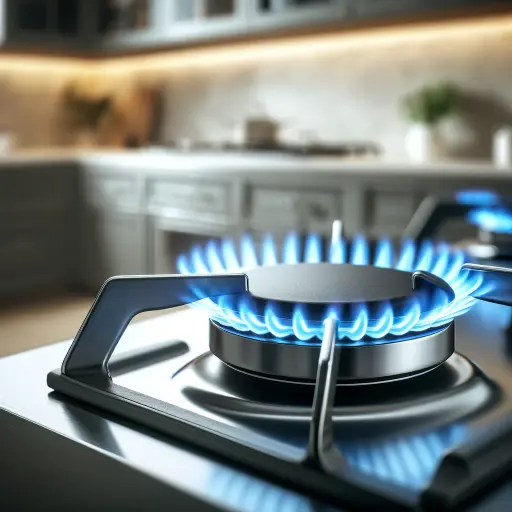
Learn how this orchestration of elements empowers you to achieve everything from delicate simmering to hearty boiling.
Balancing the Flame: Achieving Cooking Equilibrium
Unravel the art of even heat distribution, ensuring that every morsel receives equal attention. Bid farewell to overcooked edges and underdone centers as you command the equilibrium that defines culinary excellence.
Stay with us as we venture further into the heart of gas stove mechanics. In our next exploration, we’ll uncover the intricate components that contribute to your stove’s prowess, granting you culinary mastery like never before.
Types of Gas Stoves
Explore the Diverse Landscape of Gas Stove Types, Unveiling a World of Culinary Possibilities;-
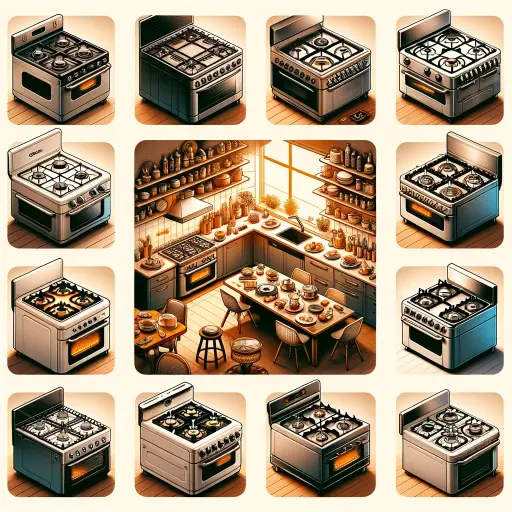
Fuel Used
Discover the Varieties of Gas Stoves Based on the Fuel They Utilize
- Natural Gas Stoves:
- Utilize natural gas from utility lines as the primary fuel source.
- Cost-effective and readily available, ideal for homes with gas connections.
- Consistent heat output for precision cooking.
- Propane Gas Stoves:
- Designed for areas without natural gas infrastructure.
- Propane tanks supply fuel, offering flexibility in placement.
- Perfect for outdoor cooking and remote locations.
Burners
Uncover the Gas Stove Types Based on the Number of Burners
- Single Burner Stoves:
- Compact and space-efficient, suitable for small kitchens.
- Ideal for solo cooks or limited cooking needs.
- Portability makes them excellent for camping or travel.
- Double Burner Stoves:
- Increased cooking capacity with two burners.
- Suitable for couples or small families.
- Versatile for preparing multiple dishes simultaneously.
- Multi-Burner Stoves:
- Offer three or more burners, catering to larger households.
- Provide ample cooking space for elaborate meals.
- Allow efficient multitasking during cooking sessions.
Comparing the Types
Pros and Cons of Different Gas Stove Types: Choosing What Fits Your Lifestyle
- Natural Gas Stoves:
- Pros: Cost-effective, consistent heat, eco-friendly.
- Cons: Requires a gas connection, limited portability.
- Propane Gas Stoves:
- Pros: Portable, versatile placement, usable in off-grid areas.
- Cons: Reliance on propane availability, occasional refills.
- Single Burner Stoves:
- Pros: Compact, portable, energy-efficient.
- Cons: Limited cooking capacity, not suitable for larger meals.
- Double Burner Stoves:
- Pros: Enhanced cooking capacity, suitable for small families.
- Cons: May require more space, not ideal for extensive cooking.
- Multi-Burner Stoves:
- Pros: Ample cooking space, versatile for elaborate meals.
- Cons: Larger footprint, higher fuel consumption.
The Choice is Yours
Selecting the Perfect Gas Stove Type to Elevate Your Culinary Experience.
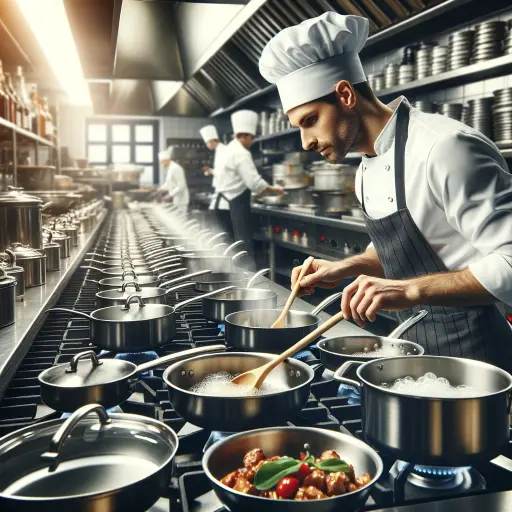
As you explore the world of gas stoves, consider your cooking needs, kitchen space, and lifestyle. Whether it’s the convenience of natural gas, the flexibility of propane, or the cooking prowess of multi-burner stoves, your choice will redefine your culinary adventures.
Each type brings a unique blend of efficiency and innovation to your kitchen, allowing you to cook with confidence and creativity.
Materials and Sustainability
Green Materials in Gas Stove Construction
Towards Eco-Friendly Designs Embark on a journey into eco-conscious design as we explore the incorporation of green materials in gas stove construction. Witness how sustainable choices are shaping the future of kitchen appliances, reducing environmental impact while maintaining performance and aesthetics.
Evaluating Environmental Impact
Components, Manufacturing, and Disposal Dive into the comprehensive assessment of gas stove environmental impact. From the sourcing of materials to the manufacturing process and eventual disposal, understand the lifecycle and make informed choices that align with your sustainability values.
Navigating Sustainability
Practices Adopted by Responsible Manufacturers Uncover the responsible practices embraced by forward-thinking manufacturers. Discover their commitment to sustainability, whether it’s efficient energy use, reduced emissions, or end-of-life recycling initiatives. Navigate the landscape of conscientious choices that contribute to a greener planet.
Stove Installation
Installation Essentials
Gas Connections, Ventilation, and Safety Measures Embark on a safe and seamless gas stove installation journey. Delve into the essentials of setting up gas connections, ensuring proper ventilation, and implementing crucial safety measures. Your cooking sanctuary awaits with a secure and functional gas stove setup.
Step-by-Step Guide
Installing Built-In and Freestanding Gas Stoves Navigate the installation process with our step-by-step guide tailored to both built-in and freestanding gas stoves. From unpacking to final connections, follow our concise instructions to transform your kitchen into a culinary haven. Whether you’re a DIY enthusiast or seeking professional help, this guide ensures a successful installation.
Stay with us as we venture further, unraveling intricate details and guiding you through essential aspects of gas stoves. Our comprehensive exploration continues, equipping you with insights and knowledge to make informed decisions for a sustainable kitchen setup and a seamless stove installation experience.
Parts of Gas Stoves
Burners
Igniting Culinary Brilliance At the heart of every gas stove lies the burners, where the magic of cooking begins. These circular elements emit controlled flames that deliver the heat necessary to turn raw ingredients into flavorful dishes. By adjusting the knobs, I dictate the intensity of the flames, allowing me to simmer, sauté, or sear with precision.
Grates
The Sturdy Support for Culinary Artistry Above the burners, I find the grates that provide a stable surface for my cookware. Often made of cast iron or stainless steel, these robust components ensure even heat distribution. Their sturdy design accommodates various pot and pan sizes, allowing me to orchestrate multiple dishes simultaneously.
Knobs and Controls
Navigating Culinary Control To fine-tune my culinary creations, I turn to the knobs and controls. These intuitive interfaces let me adjust flame intensity with a simple twist, granting me mastery over temperature regulation. Whether I’m delicately melting chocolate or searing a succulent steak, these controls are my culinary compass.
Oven
Expanding Culinary Horizons For those seeking versatility beyond stovetop cooking, the oven is a gateway to new culinary dimensions. Controlled by separate knobs, the oven allows me to bake, roast, and broil with precision. With its internal heating element, I can explore an array of recipes, from decadent cakes to perfectly roasted vegetables.
Broiler
Adding a Finishing Touch Situated within the oven, the broiler is a hidden gem for creating delectable crusts and finishes. I toggle this feature to give dishes a golden brown top, from bubbling cheese on lasagnas to caramelized sugars on crème brûlées. This quick and powerful burst of heat adds an elegant touch to my culinary creations.
Drip Trays
Keeping Things Tidy To keep my cooking area pristine, gas stoves feature drip trays beneath the burners. These removable trays catch any spills, preventing them from accumulating and making cleanup a breeze. By maintaining a tidy workspace, I can focus on crafting delectable dishes without the worry of messes.
Ventilation:
Clearing the Culinary Path Gas stoves also require proper ventilation to ensure safe and efficient cooking. Overhead hoods or exhaust fans draw out smoke, steam, and odors, creating a comfortable environment while preventing potential safety hazards.
Stove Models
The Landscape of Gas Stove Models
From Traditional to High-Tech Navigating the diverse world of gas stove models is a culinary adventure in itself. From classic designs that evoke nostalgia to sleek, high-tech options that redefine modern kitchens, I explore a spectrum of possibilities. Whether I’m drawn to the charm of tradition or the allure of innovation, each model promises a unique culinary experience.
Selecting the Perfect Fit
Customizing Features and Aesthetics In my journey to find the ideal gas stove, customization takes center stage. With a plethora of features and aesthetics to choose from, I tailor my choice to match my cooking style and kitchen decor. I weigh the advantages of varying burner configurations, oven capacities, and technological enhancements, ensuring that my gas stove aligns seamlessly with my culinary aspirations.
Advantages of Gas Stoves
- Instant Heat: Gas stoves heat up quickly, reducing cooking time and making meal preparation faster.
- Precise Control: With adjustable flame levels, I can easily control the heat for delicate simmering or rapid boiling.
- Even Cooking: Gas burners distribute heat evenly, preventing unevenly cooked food.
- Visual Cooking: Flames provide a visual indicator of the heat level, helping me monitor and adjust as needed.
- Cooking During Power Outages: Gas stoves work without electricity, ensuring I can cook during power failures.
- Lower Energy Costs: Gas is often more affordable than electricity, leading to potential savings on energy bills.
Disadvantages of Gas Stoves
- Safety Concerns: Open flames pose a fire risk, demanding caution while cooking.
- Indoor Air Quality: Gas stoves can emit pollutants, affecting indoor air quality and potentially causing health issues.
- Installation Constraints: Gas stoves require proper ventilation and gas connections, limiting placement options.
- Regular Maintenance: Burners and igniters need periodic cleaning and maintenance for optimal performance.
- Initial Cost: Gas stoves can have higher upfront costs due to the installation and purchasing of gas lines.
- Ignition Issues: Pilot lights can go out, requiring manual relighting, or electronic igniters may fail over time.
Conclusion
In conclusion, selecting the right gas stove for your home is about much more than just choosing a cooking appliance; it’s about enhancing your culinary experience, ensuring safety, and optimizing your kitchen’s efficiency.
Throughout this guide, we’ve explored various aspects of gas stoves, from understanding the basics of how they work to navigating the latest features and innovations in the market.
We hope this comprehensive exploration helps you make an informed decision that suits your cooking style, budget, and aesthetic preferences. Remember, the best stove is one that fits seamlessly into your lifestyle, offering reliability and performance without compromising on safety or style.
